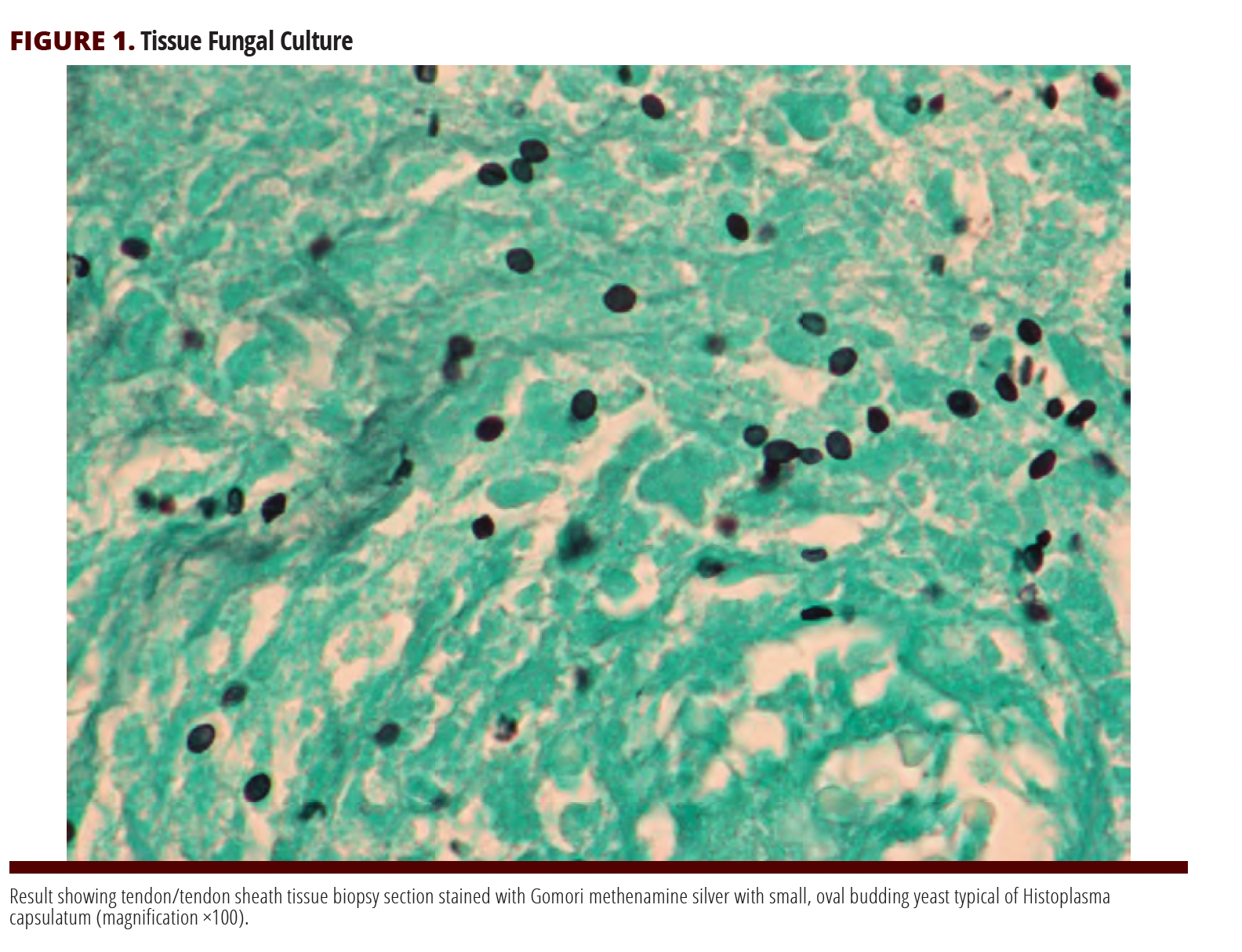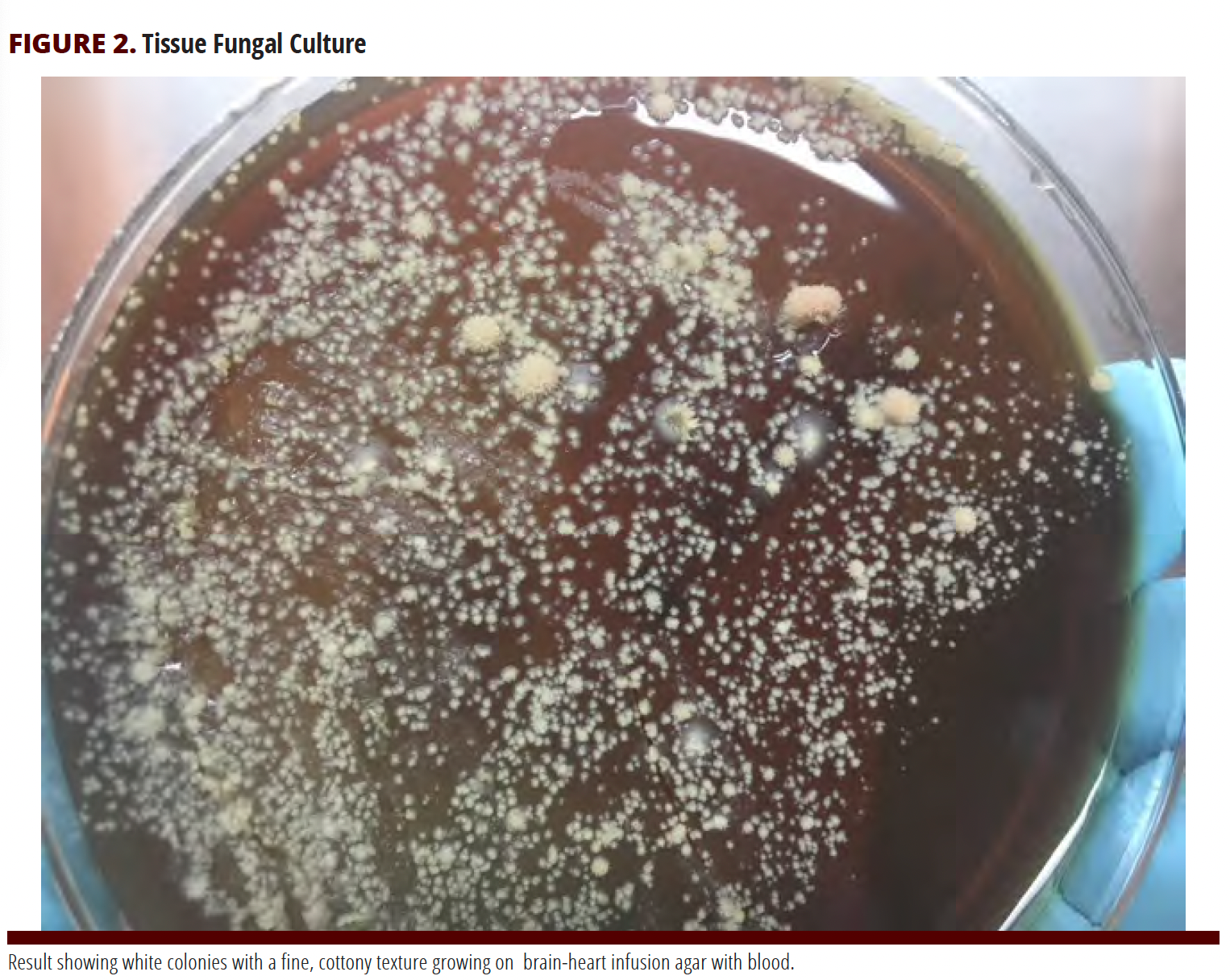final diagnosis
Histoplasma Tenosynovitis
History of present illness
A 40-year-old man with a long-standing history of systemic lupus erythematosus and a 2-week history of edema, erythema, and tenderness in his right hand and arm presented with biopsy results showing lupus nephritis. At the time, it was determined that these signs and symptoms could be due to a lupus attack. Due to concern for concurrent cellulitis, his home prednisone dose was increased from 15 mg to 40 mg orally daily, and mycophenolate mofetil (MMF) was later increased to 1000 mg orally twice daily, and he was started with clindamycin 600 mg orally daily. 3 times for two weeks. Symptoms resolved. Eight months later, he presented with 3 weeks of worsening pain and edema in his right hand, with no previous trauma, fever, chills, or night sweats.
Medical history
There is a history of systemic lupus erythematosus, lupus nephritis, and cerebrovascular accident.
main drug
MMF 1000 mg PO twice daily
Prednisone 40 mg orally daily
epidemiological history
He works as a computer engineer at a local university. He is married and lives with his wife and son. He has not recently traveled domestically or internationally. He didn’t recall any insect bites. He had a dog, but no fish, an aquarium, or access to salt water. He had no history of sexually transmitted diseases. I deny hiking or camping outdoors. He denies using illegal drugs, smoking and drinking alcohol. His family history is unremarkable.
Body checkup
The patient appeared to be doing well and was not in cardiopulmonary distress but was in mild pain. His blood pressure is 130/80 mm Hg, heart rate is 86 beats per minute, temperature is 98 °F (36.7 °C), and respiratory rate is 16 breaths per minute. His right hand and fingers were swollen, erythematous, warm to touch, and he was in pain and unable to bend his fingers. The edema of the right arm extended to the middle arm, and the erythema extended to the axilla, without lymphadenopathy. The remaining physical examination results were normal.
study
The white blood cell count was 7.42 K/μL (reference range 4.4-11.3 K/μL), of which 94% were polymorphonuclear leukocytes, 2% lymphocytes, and 3% monocytes. The hemoglobin level was 10 g/dL (reference range, 13.8-17.4 g/dL), and the hematocrit level was 29.5% (reference range, 41%-51%). The platelet level was 179 K/μL (reference range, 150-450 K/μL). His creatinine level was 2 mg/dL (reference range, 0.6-1.3 mg/dL) and blood urea nitrogen level was 100 mg/dL (reference range, 7-20 mg/dL). His C-reactive protein (CRP) level was 34.2 mg/L (reference range, < 5 mg/L). X-rays of the right hand and arm were normal. MRI scan of the right hand showed changes consistent with circumferential synovial proliferation/thickening involving the second, third, and fourth flexor digitorum profundus and flexor digitorum superficialis tendons within the tendon sheaths, favoring an inflammatory process.
clinical courses
The patient underwent joint aspiration of the right interphalangeal joint, and only extracellular sodium urate crystals were seen. Intravenous methylprednisolone sodium succinate 60 mg daily was started to treat acute gout attacks without significant improvement. The CRP level continued to increase to 54mg/L. The patient then underwent extensive debridement of the volar and dorsal aspects of the right index finger and arthrotomy and synovectomy of the proximal interphalangeal joint of the right index finger. Gram stain, fungal stain, and crystal stain all yield negative results. Tissue samples were also sent for pathology testing. At the time of discharge, 60 mg of oral prednisone was administered daily.

Diagnostic procedures and results
After discharge, the final pathological results showed septate hyphae with round and pear-shaped nodules and knotty thick-walled macroconidia, with Histoplasma capsulatum (Figure 1-3).serum Histoplasma The antibody hyphal complement fixation (CF) result was 1:16 and the yeast CF result was 1:16. Clostridium capsulatum Identified by DNA probe (drug sensitivity: amphotericin B 0.06 μg/mL, itraconazole ≤ 0.03 μg/mL, posaconazole ≤ 0.03 μg/mL).
Treatment and follow-up
The patient was started on oral itraconazole 200 mg three times a day as a loading dose for 3 days. As maintenance therapy, the dose was reduced to 200 mg twice daily at a therapeutic itraconazole level. He has maintained this regimen as long-term suppressive therapy, taking both MMF and prednisone. No reactivation was noted during future outpatient follow-up.

discuss
Clostridium capsulatum is an intracellular dimorphic fungus that causes respiratory and systemic infections in both immunocompetent and immunocompromised patients.1 dimorphic traits Histoplasma It is determined by the environment in which it is isolated. It exists as a mold in soil at temperatures of 20 to 25 °C.1 Histoplasma In this form, the appearance is septate hyphae with round and pear-shaped nodules and knobby, thick-walled macroconidia. On the other hand, it appears as small, oval-shaped budding yeast in host tissues at higher temperatures (approximately 37°C).1 It is endemic in certain areas of North America, South America, Africa, and Asia, with some reports in Europe. In the United States, most cases occur in Ohio and the Mississippi Valley.2 Inhalation from aerosolized soil is the most common mode of transmission and is often exacerbated by activities that disrupt soil, particularly those rich in bird and bat guano. This excrement promotes the growth of the organism by accelerating sporulation.2
Histoplasma Tenosynovitis has been reported, often with bony involvement. Whether the initial focus of infection is bone or tendon sheath is unclear, as bone infection may precede the latter.3 In our patients, we use itraconazole, an antifungal azole, which disrupts fungal cell walls by interfering with chitin synthesis, as maintenance therapy.4 It is widely distributed in tissues such as bone, liver, sputum, fat and keratin.4
Cell-mediated immunity is critical in limiting the extent of histoplasmosis but cannot completely eradicate it.2 Patients with defective or low cell-mediated immunity due to diseases such as AIDS5 or from medications (such as methotrexate6 and tumor necrosis factor inhibitors7), there is a risk of reactivation. Our patient was taking prednisone and MMF, which act on cell-mediated immunity and inhibit the main mechanisms that suppress the virus. Clostridium capsulatum. Corticosteroids reduce responses to antigens and mitogens by modulating different mechanisms in the lymphocyte proliferative cascade, including direct effects on the lymphocytes themselves.8 MMF can affect T cell and B cell activity by depleting guanosine nucleotides and therefore can affect cell-mediated immunity and humoral immunity.9 Both drugs played a role in our patient’s reactivation.
Histoplasmosis is a common endemic fungal infection in patients with AIDS.10 In a prospective multicenter trial of itraconazole as maintenance therapy for histoplasmosis in patients with AIDS, a once-daily dose of 200 mg was highly effective in most patients.eleven However, relapse is common unless suppressive maintenance therapy is added. Most patients receive lifelong antifungal therapy.5 However, studies have shown that discontinuing antifungal therapy in HIV patients on ongoing antiretroviral therapy with a sustained immune response is safe and a possible option for this population.12
In conclusion, immunocompromised patients, particularly those with compromised cell-mediated immunity, are at high risk for developing invasive and disseminated histoplasmosis and are associated with high rates of recurrence. Treatment with itraconazole is effective, but if immunosuppression is incorrect, long-term treatment may be required.

refer to
- Woods JP. Revisiting an old friend: progress in understanding the pathogenesis of Histoplasma capsulatum. journal of microbiology. 2016;54(3):265-276. Number: 10.1007/s12275-016-6044-5
- Wheat LJ, Freifeld AG, Kleiman MB, et al; Infectious Diseases Society of America. Clinical practice guidelines for the management of patients with histoplasmosis: 2007 update from the Infectious Diseases Society of America. clinical infectious diseases. 2007;45(7):807-825. Number: 10.1086/521259
- Nursing SB, Lacey SH. Recurrent histoplasmosis of the wrist: a case report. Journal of Hand Surgery. 1998 Nov;23(6):1112-1114. Number: 10.1016/S0363-5023(98)80025-7
- Mangino JE, Pappas PG. Itraconazole is used to treat histoplasmosis and blastomycosis. International Journal of Antimicrobial Agents. 1995;5(4):219-225. Number: 10.1016/0924-8579(95)00010-6
- Wheat LJ, Connolly-Stringfield PA, Baker RL, et al. Disseminated histoplasmosis in acquired immunodeficiency syndrome: clinical manifestations, diagnosis and treatment, and literature review. Medicine (Baltimore). 1990;69(6):361-374. Number: 10.1097/00005792-199011000-00004
- Wit LA, Steiner F, Coffman M, Weber D, Wheat LJ. Disseminated histoplasmosis occurs in a patient receiving low-dose methotrexate for psoriasis. Arch Dermatology. 1992;128(1):91-93.
- Jain VV, Evans T, Peterson MW. Reactivation of histoplasmosis after anti-tumor necrosis factor alpha therapy in patients from non-endemic areas. respiratory medicine. 2006;100(7):1291-1293. doi:10.1016/j.rmed.2005.09.020
- Cohen Los Angeles. Effects of corticosteroids on host defense mechanisms. veterinary practice magazine. 1991;5(2):95-104. doi:10.1111/j.1939-1676.1991.tb00939
- Allison AC. Mechanism of action of mycophenolate mofetil. lupus. 2005;14(Suppl 1):s2-s8. Number: 10.1191/0961203305lu2109oa
- Wheat LJ, Chetchotisakd P, Williams B, Connolly P, Shutt K, Hajjeh R. Factors associated with severe manifestations of histoplasmosis in AIDS. clinical infectious diseases. 2000 Jun;30(6):877-81. Number: 10.1086/313824
- Hecht FM, Wheat J, Korzun AH, et al. Itraconazole maintenance therapy for HIV histoplasmosis: a prospective, multicenter trial. Journal of Acquired Immunodeficiency Syndrome Retrovirus. 1997;16(2):100-107. Number: 10.1097/00042560-199710010-00005
- Goldman M, Zackin R, Fichtenbaum CJ, et al; AIDS Clinical Trials Group A5038 Study Group. Safety of maintenance therapy with discontinuation of disseminated histoplasmosis after immune response to antiretroviral therapy. clinical infectious diseases. 2004;38(10):1485-1489. Number: 10.1086/420749

